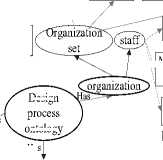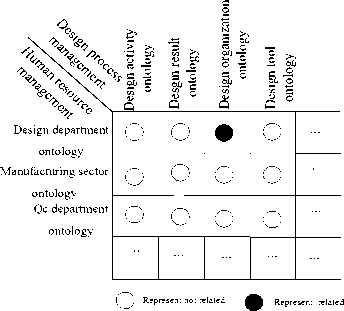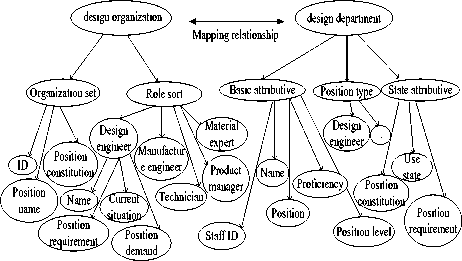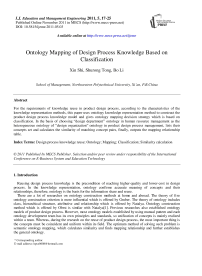Ontology Mapping of Design Process Knowledge Based on Classification
Автор: Xin Shi, Shurong Tong, Bo Li
Журнал: International Journal of Education and Management Engineering(IJEME) @ijeme
Статья в выпуске: 5 vol.1, 2011 года.
Бесплатный доступ
For the requirements of knowledge reuse in product design process, according to the characteristics of the knowledge representation methods, this paper uses ontology knowledge representation method to construct the product design process knowledge model and gives ontology mapping decision strategy which is based on classification. In the basis of choosing "design department" ontology in human resource management as the heterogeneous ontology of "design organization" ontology in product design process management, lists their concepts set and calculates the similarity of matching concept pairs, finally, outputs the mapping relationship table.
Design process knowledge reuse, Ontology, Mapping, Classification, Similarity calculation
Короткий адрес: https://sciup.org/15013615
IDR: 15013615
Текст научной статьи Ontology Mapping of Design Process Knowledge Based on Classification
-
1 . Introduction
-
2 .Product Design Process Ontology
Reusing design process knowledge is the precondition of reaching higher-quality and lower-cost in design process. In the knowledge representation, ontology confirms accurate meaning of concepts and their relationships, therefore, ontology is the basis for the information share and reuse.
There are a lot of researches on ontology construction methods at home and abroad. The theory of five ontology construction criterion is more influential which is offered by Gruber. The theory of ontology includes class, hierarchical structure, attributive and relationship which is offered by Natalya. Ontology construction method which is offered by Obrst is similar with Natalya[1]. Previous researches also established ontology models of product design process. However, most ontology models established by using manual pattern and each ontology development team has its own principles and standards, so unification of concepts is mainly realized within a team. Whereas, during the research on the reuse of product design process, the most important thing is the concepts must be coincident and uniform within its field. The optimum method of solving such problem is semantic ontology mapping, which calculates similarity and finds mapping relationship and further establishes the general ontology.
* Corresponding author.
For this reason, this paper constructs design process knowledge ontology model, takes “design department” ontology in human resource management as the heterogeneous ontology of “design organization” ontology in product design process management, chooses ontology mapping strategy based on classification and finds their ontology mapping relationship. As a result, it supports to realize more efficient share and reuse of product design process knowledge.
-
A. The Concept of Product Design Process Ontology
Definition 1 (Product design process ontology): Product design process ontology is a kind of detailed characteristic description of the concepts and relationships which abstracted from the design process, and it is the basis of realizing reuse of knowledge in product design process field [2].
Product design process ontology can be defined as O ( C , R ) , in which:
-
• O denotes product design process ontology;
-
• C denotes concepts collection of O ; pro pro
-
• R denotes relationships collection of O . pro pro
-
B. Product Design Process Ontology Model
-
1) Construct the relationship of design process ontology
Through the research of product design process, product design process ontology is divided into design process activity ontology, design process tool ontology, design process result ontology, design process regulation ontology, design process standard ontology, design process experience ontology and design process organization ontology. Part of the concepts and their relationships are shown in Fig. 1.
-
2) Construct the attributive of design process ontology
In the basis of construction of concept and relationship of product design process, gives the attributive definition of them. To the concept of “organization set”, defines the attributives of ID, position name, position constitution and storage. To the concept of “QFD figure”, defines the attributives of ID, consent, originate, date, publisher, storage and amendments. To the concept of “plan stage”, defines the attributives of ID, target, activity, staff, result, storage, and so on.
-
3) Fill the example of design process ontology
3.Ontology Mapping
In the basis of construction of relationship and attributive of product design process, fills the example of product design process and forms the part of product design process ontology as shown in Fig. 2.
-
C. Concept of Ontology Mapping
Definition 2 (Ontology mapping): Ontology mapping refers to confirming how ontology is mapped or mutually related. During exact mapping process, ontology mapping mainly includes 6 kinds of mapping models: 1:1, 1:n, n:1, 1:null, null:1and n:m [3].
Definition 3 (Similarity): The similarity value is among 0 and 1. Sim ( s , s ) is similarity between concept s and concept s [4].
-
• sim ( s , s ) = 1 :denotes concept s and concept s 2 are identical;
-
• sim ( s , s ) = 0 :denotes concept s and concept s are totally different.
-
D. Ontology Mapping Based on Classification
Ontology concept mapping based on natural language disposal is very practical to semantic web, and its basic thought is as follows: first, it searches a group of relevant documents as sample document based on ontology concept; second, it constitutes words eigenvector by considering parameters such as appearance frequency of words in document and their relationships with other words; finally, it calculates similarity of concepts based on concepts eigenvector [5].
In order to reduce complexity of similarity calculation, ontology concept mapping method based on classification is brought out, and its basic thought is as follows: dividing ontology database into several smallsize ontology trees through classification, and establishing similarity mapping on root node; thus, all similarity calculations are established among classification trees where root node of similarity mapping lies. So, the complexity of concepts similarity calculation is reduced significantly [6-8]. The exact procedures are as follows:
-
1) Give definition
Basic relationship among concepts is inclusion relationship in ontology database, which is usually described in tree structures. The following definitions are made:
-
• O and O are two ontology databases mapped;
-
• C and C are leaf concept nodes of ontology databases;
-
• W and W are classification nodes of ontology databases, and W ∈ O , W ∈ O . i j i 1 j 2
Product design process
Sub-class
Method Procedure 1
Question
-naire
QFD
Procedural result
J Instance s
The end result
I Instances
Organization set
Staff
Principle diagram
revision
Conceptual model
Process plan
Design manual
Figure 1. Part of relationship of product design process
ID target description
Procedural result
Produce concept
Evaluate concept
Plan phase
order
Concept
design activity
Storage ID and
t
Position name
Determine concept order activity
Has task

set
Design process ontology
Engineer
Design
Engineer questionnaire
Has
Part-of
Part-of
Position constitution
technician and
Post demand Current
Manufacturing situation
and
Position requirement
Preliminary
design

Procedural result result and QFD figure
Belong-to
The end result
Design manual
/I—I content
date
Conceptual modle
Attribut
Process plan result
— storage
Detail desi gn

content
ID vision name
Figure 2. Part of design process knowledge ontology
sketch
1-^^-- u
Principle diagram revisions

amendments evaluation originate date publisher storage
-
2) If two classification nodes from the two ontology databases o and o are similar, all nodes included in classification tree Tree and Tree can be mapped.
-
3) Procedure of similarity calculation
After mapping relationship of classification nodes is acquired, similarity calculation should be carried out on concept nodes in classification tree which guided by mapping classification nodes [9]. The exact procedures and calculation formula are as follows:
• Take cartesian product of all elements C e Tree and C e Tree as key phrase under classification tree
Tree and Tree ,search a sample document for each set of key phrases (e.g. Google search, get the first value), and form a collection D , the amount of sample document collection is K = Number ( Tree ) x Number ( Tree ) .
• Record appearance frequency of possible mapping pair in each sample document as J , record appearance frequency of concept C in sample document as f k ,record appearance frequency of concept C in sample document as f k , then similarity calculation formula can be gotten:
2 x f k sim ( C„ C ) = E (—5" ) .
( 1 )
D e Ducument J. + J,
Basic thought of (1) is: appearance frequency of mapping pair of which sim ( C , C ) > 0.6 is higher than that of mapping pair of which sim ( C , C ) < 0.6 in sample documents (threshold value of this paper is set to be 0.6, which can be regulated according to actual application field).
-
4) Concept nodes which can not establish mapping relationship should be calculated according to the traditional similarity calculation method.
4.Design Process Ontology Mapping based on Classification
This paper chooses human resource ontology as the heterogeneous ontology of product design process ontology to establish their semantic ontology mapping relationship.
-
E. Give Definition
In ontology database, the basic relationship among concepts is inclusion relationship. Describes relationship between product design process management system and human resource management system with tree structure, and the definitions are as follows:
-
• O is design process ontology database, O is human resource ontology database;
-
• C is leaf concept nodes of product design process ontology database, C is leaf concept nodes of human resource ontology database, and C ∈ O , C ∈ O ;
-
• W is classification nodes of design process ontology database, and W is classification nodes of human resource ontology database, and W ∈ O , W ∈ O ;
-
• Tree is classification tree of product design process, Tree is classification tree of human resource management, and ∃ C ⊂ W , ∃ C ⊂ W .
-
F. Discover Sharing Knowledge
Establishes the Correlation matrix of product design process management and human resource management and discovers their sharing knowledge. Fig. 3 shows that “design organization” ontology in product design process management and “design department” ontology in human resource management is possible sharing knowledge while filer out the not related knowledge.
-
G. Determine Matching Concepts Set
Takes “design organization” Tree and “design department” Tree as the example of classification tree. “Design organization” Tree comes from design process ontology database O and “design department” Tree comes from human resource ontology database O . human
Concepts set of “design organization” Tree includes: organization set, ID, position name, position constitution, role kind, design engineer, manufacture engineer, technician, product manager, material expert, name, position demand, current situation and position requirement.
Concepts set of “design department” Tree includes: basic attributive, staff ID, name, position, proficiency, position level, position type, design engineer, manufacture engineer, technician, product manager, material expert, state attributive, position constitution, use state and position requirement.
Mapping relationship between “design organization” Tree and “design department” Tree will be built by experts in the field, as shown in Fig. 4.

Figure 3. Classification tree of ontology database

Design process ontology database O1
Human resource ontology database O2
-
Figure 4. Instances of ontology tree

Search дачапсеа
current-situation;use-state
Search: @ the web 0 pages from Hong Kong
Web Ifl Show options..
Results
1 -10
of about
12,600,000
for
current
review of the current situation The use of eleaminq in medical...
by AP Choules - 2007 - Cited by 27 - Related articles review of the current situation. The use of elearning in medical education: a... This article endeavours to review the current "state of the art2 in...
-
Figure 5. Sample instance of concept mapping documents
-
H. Mapping Decision
After acquiring matching concepts set between “design organization” and “design department”, the paper carries out similarity calculation of concept nodes in classification tree which guided by mapping classification nodes.
-
1) Calculate frequency value of mapping pairs
Searches a sample document in each possible mapping pairs in “design organization” and “design department” (e.g. Google search, get the first value), and form a sample document collection. Takes (current-situation, usestate) as an example of the mapping pair, exact sample document is shown in Fig. 5.
With appearance frequency of mapping pair(current-situation, use-state)in all sample documents, the paper can acquire appearance frequency f k of concept “current-situation”, appearance frequency f k of concept “usestate”, and appearance frequency f k of mapping pair (current-situation, use-state) in sample document. Similarly, according to the mapping relationship which experts established, this paper can acquire the appearance frequency ( fk , fk , fk ) of other possible mapping pairs which from concepts in “design organization” and concept in “design department” as shown in Table I.
-
2) Calculate similarity value of mapping pairs
According to (1), similarity of mapping pair (current-situation, use-state) can be acquired.
sim(current - situation, use - state) = 0.884 (2)
Similarly, the similarity value of other concept mapping pairs which from “design organization” ontology and “design department” ontology can be acquired.
Table II shows the similarity of mapping pairs which from concepts in “design organization” ontology and the concept “use-state” in “design department” ontology. Table II also shows that possible concept pairs are (current-situation, use-state) and (post-requirement, use-state) when concept similarity threshold value is 0.6.Actually, the meaning of (post-requirement, use-state) can be estimated, so this kind of pseudo-mapping can be eliminated when experts confirm mapping relationship. Thus, the concept pair with maximum similarity is (current-situation, use-state) between the concepts in “design organization” and the concept “use-state” in “design department”.
-
3) Output mapping relationship
5.Conclusion
Similarly, the paper can acquire other similarity value of possible mapping pairs established by experts and find one of which the similarity value is larger than 0.6. The concept pairs with maximum similarity value in two ontology databases are shown in Table III.As the mass calculation,this paper will not list the calculation procedures any more.
In the basis of product design process knowledge ontology model established, this paper chose ontology mapping method based on classification as decision-making strategy; took “design department” ontology in human resource management as heterogeneous ontology of “design organization” ontology in product design process management; found their ontology mapping relationship; adopted similarity calculation method to carry out similarity of part of mapping pairs. Future work focus on the methods of transforming the knowledge denoted in heterogeneous ontology with mapping relationship for efficient share and reuse of product design process knowledge in a broader scope.
Acknowledgment
The authors gratefully acknowledge the support of National Nature Science Foundation of China (No. 70771091) and the foundational research project of science and technology industry in national defence (No.Z142008A001).
TABLE I. frequency value of mapping pairs
|
(C i , C j ) |
f i k |
f j k |
k ij |
|
(current-situation, use-state) |
23 |
29 |
23 |
|
(position-name, use-state) |
6 |
12 |
6 |
|
(position-constitution, use-state) |
4 |
9 |
4 |
|
(position-requirement, use-state) |
5 |
11 |
5 |
|
(ID, use-state) |
19 |
24 |
19 |
|
(name, use-state) |
9 |
14 |
9 |
|
(position-demand, use-state) |
3 |
7 |
3 |
TABLE II. similarity value of mapping pairs
|
Concept in O 1 |
Concept in O 2 |
Sim |
|
current-situation |
use-state |
0.884>0.600 |
|
position-name |
use-state |
0.421 |
|
position-constitution |
use-state |
0.267 |
|
position-requirement |
use-state |
0.625>0.600 |
|
ID |
use-state |
0.131 |
|
name |
use-state |
0.234 |
|
position-demand |
use-state |
0.465 |
TABLE III. concept pairs with maximum similarity
|
Concept in O 1 |
Concept in O 2 |
Sim |
|
current-situation |
use-state |
0.884 |
|
role-sort |
position-type |
0.83 |
|
ID |
name-ID |
0.61 |
|
position-requirement |
position-requirement |
1 |
|
position-demand |
position-level |
0.71 |
|
position-constitution |
position-constitution |
1 |
|
design-engineer |
design-engineer |
1 |
Список литературы Ontology Mapping of Design Process Knowledge Based on Classification
- X.Guo and X.G.Li,"Research on Ontology Mapping in Heterogeneous Data Semantic Integration," Software space (in chinese) , 2008,24 (12-3): 272-274.
- W.T.Liu,"Research on Ontology-based Heterogeneous Knowledge Integration of Aviation Manufacturing Enterprise,"Academic Paper (in chinese), 2008,17:94 ~ 97.
- L.P.Zheng,"Design of Ontology Mapping Frame,"Computer Science (in chinese), 2007,34 (10): 165 ~ 167.
- Z.W.Cao, J. Qian, "An Improved Ontology Mapping Method,"Scientific Technique and Engineering (in chinese),2006,6 (19): 3078 ~ 3082.
- Q.Fu,"Research on Field Knowledge Share Based on Ontology,"Computer Integrated Manufacturing System (in chinese), 2001,11:54 ~ 57.
- J.Tang and B.Y.Liang, "Automatic Mapping of Ontology in Semanteme Web,"Chinese Journal of Computer (in chinese), vol.29,no.11,pp.1956 ~ 1976,2006.
- D.Z.Xu,"Concept Similarity Calculation in Ontology Mapping Process," Computer Engineering and Application (in chinese),2007,43(9):167~169.
- X.X.Guo and Z.Yang, "Research on Concept Similarity Calculating Method in Ontology Mapping Based on OWL," Scientific Technique and Engineering (in chinese), 2007, 7 (15): 3761 ~ 3765.
- K.Q.HE,"Ontology Elements Modeling Theory & Methods," (in chinese),Beijing: Science Press, 2008.


